Abstract
To determine the role of thyrotropin-releasing hormone (TRH) in the regulation of thyroid-stimulating hormone (TSH) secretion in the perinatal period, a physiological approach of neutralizing circulating TRH in the fetal and early neonatal rat was employed. TRH-antiserum (TRH-AS) raised in rabbits and administered daily to low iodine-propylthiouracil (LID-PTU)-fed pregnant rats from days 12 to 19 of gestation markedly impaired the rise in serum TSH to LID-PTU when compared with normal rabbit serum-treated controls. In contrast, fetal serum TSH was unaffected by TRH-AS. The binding capacity of TRH-AS in the fetal serum (111 ng/ml) far exceeded circulating TRH in the fetus. Similarly, acute TRH-AS administration to the pregnant rat fed LID-PTU markedly decreased the serum TSH concentration in the mother, but not in the fetus, 60 min after TRH-AS administration. Chronic TRH-AS administration to neonatal rats whose nursing mothers were fed LID-PTU was in-effective in decreasing the elevated serum TSH in the neonate through day 8 of life, whereas a slight but significant decrease in serum TSH was observed on day 10. Chronic daily TRH-AS administration to neonatal rats through day 10 of life had no effect on the later development of the hypothalamic-pituitary-thyroid axis. These findings suggest that TRH does not participate in TSH regulation during the perinatal life in the rat and that thyroid hormones are probably the main regulators of TSH secretion during this period. Placental TRH is not important in regulating TSH secretion in the fetal rat. Furthermore, TRH “deprivation” during neonatal life does not prevent normal later development of the hypothalamic-pituitary-thyroid axis.
Full text
PDF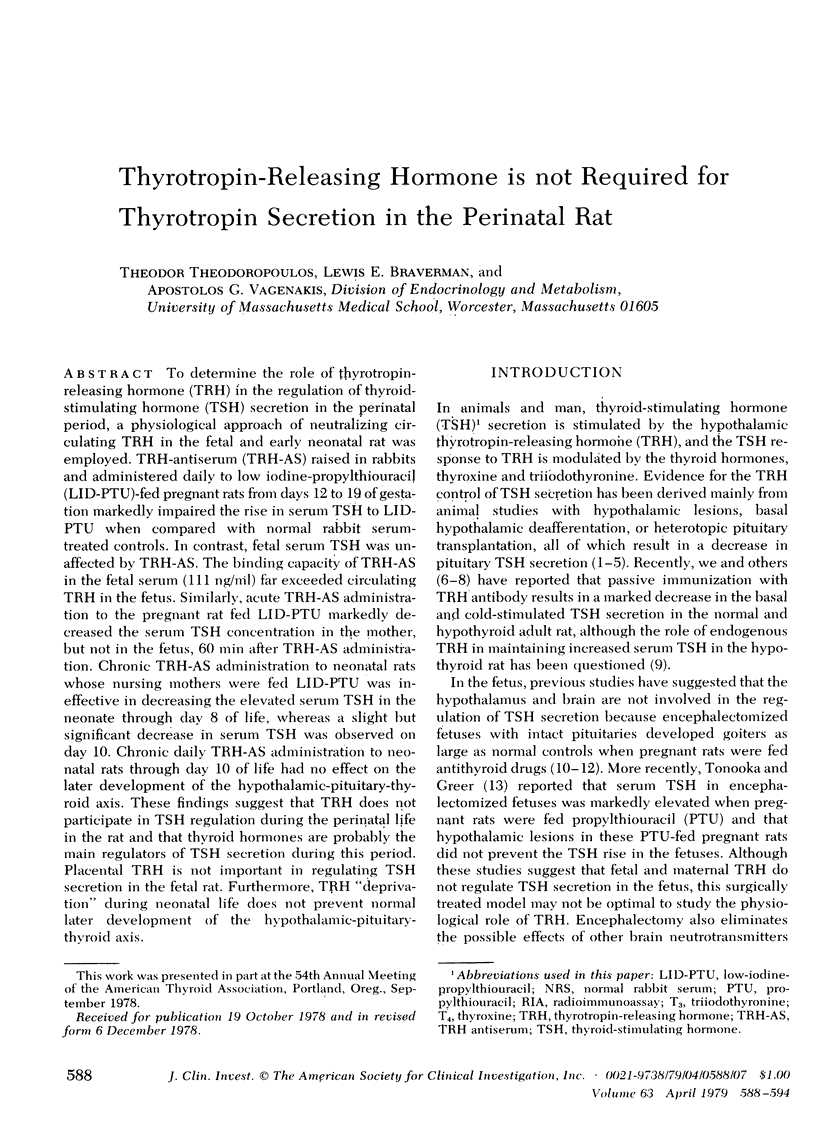
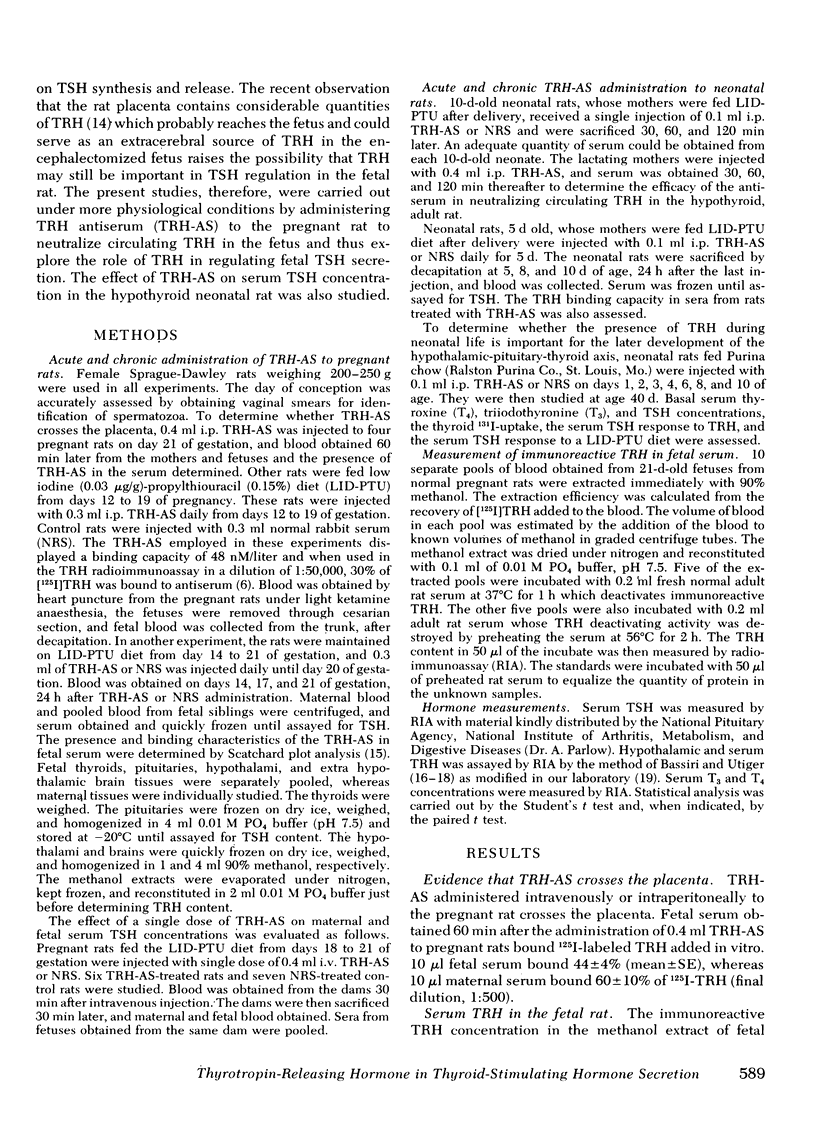
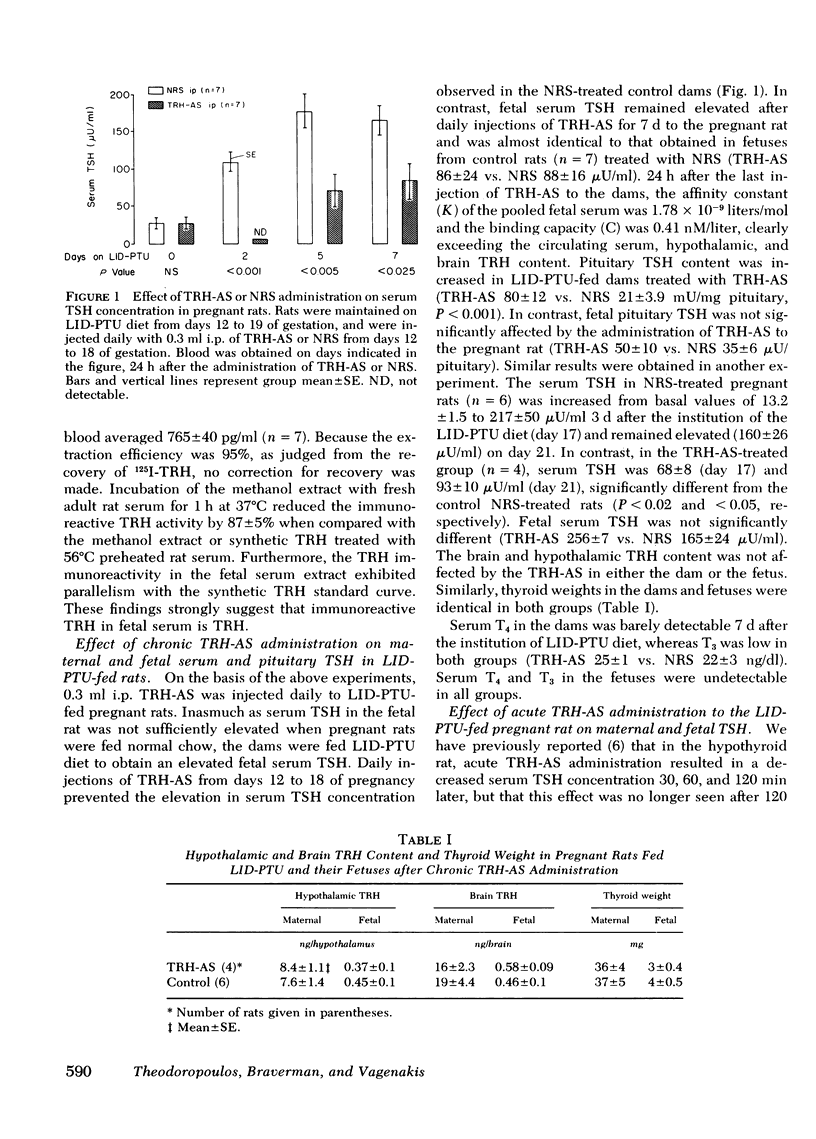


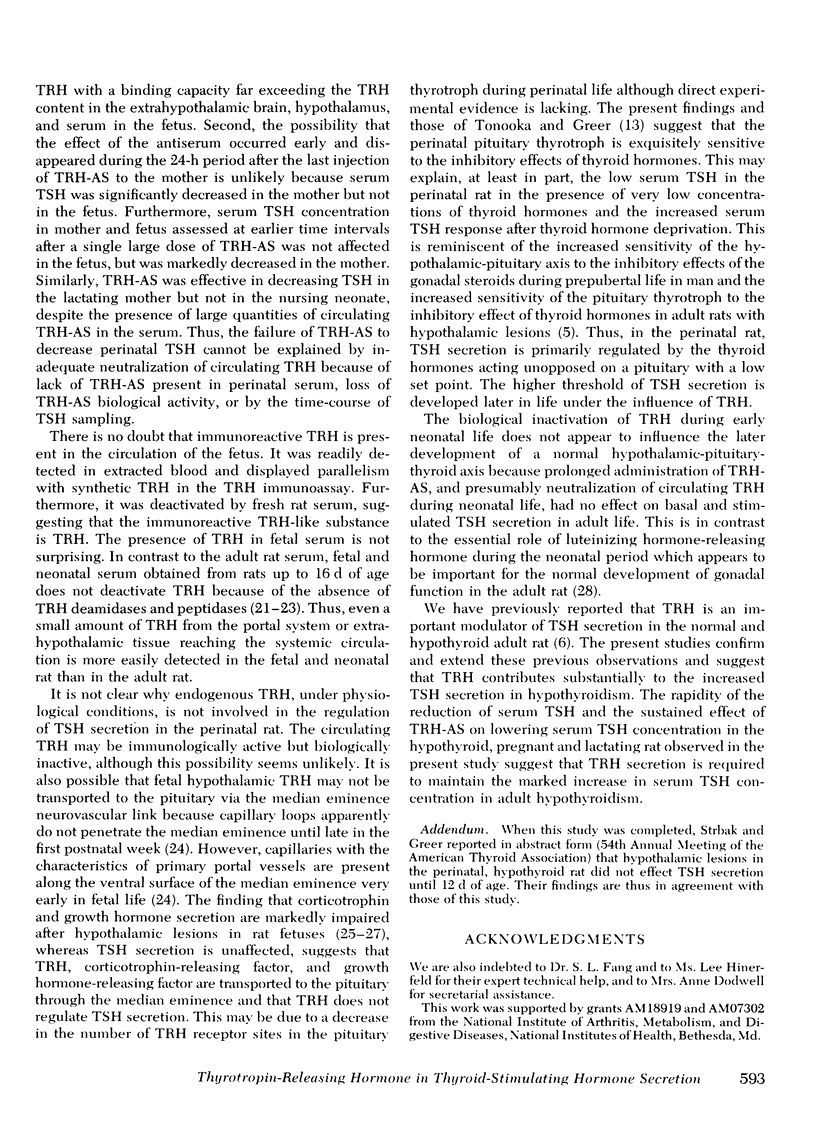
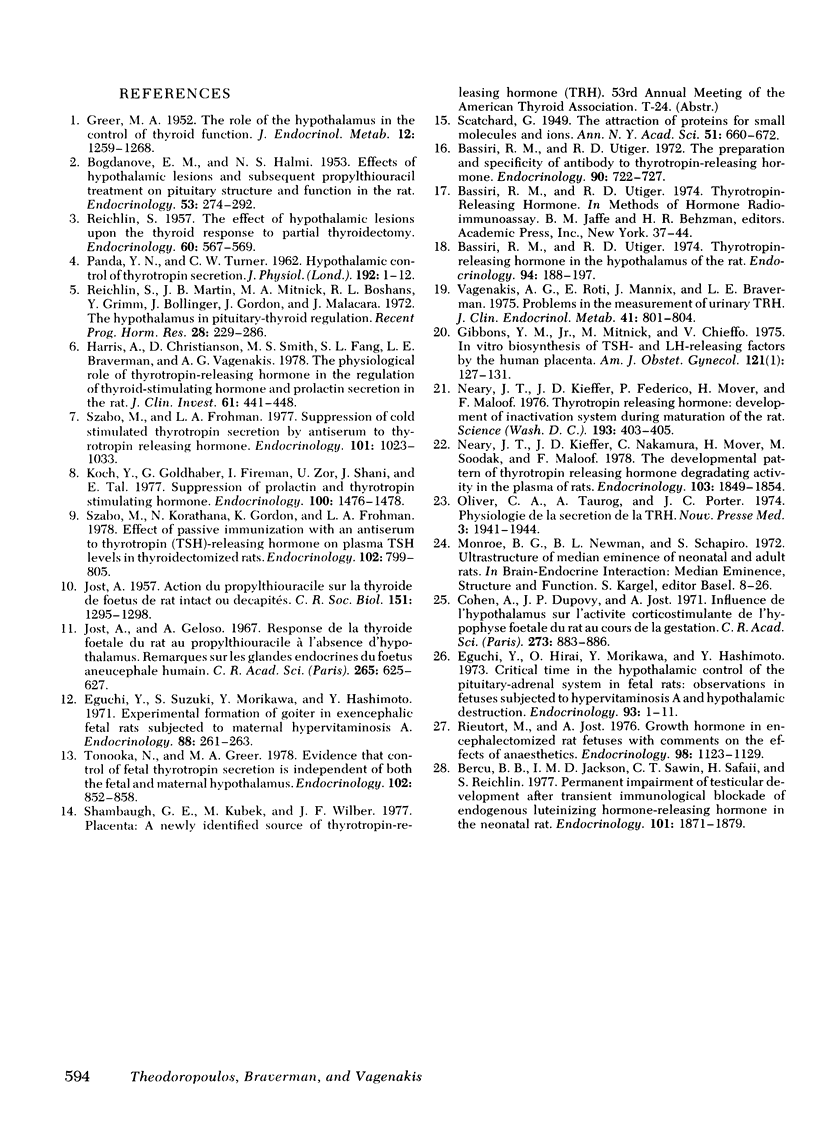
Selected References
These references are in PubMed. This may not be the complete list of references from this article.
- BOGDANOVE E. M., HALMI N. S. Effects of hypothalamic lesions and subsequent propylthiouracil treatment on pituitary structure and function in the rat. Endocrinology. 1953 Sep;53(3):274–292. doi: 10.1210/endo-53-3-274. [DOI] [PubMed] [Google Scholar]
- Bassiri R. M., Utiger R. D. The preparation and specificity of antibody to thyrotropin releasing hormone. Endocrinology. 1972 Mar;90(3):722–727. doi: 10.1210/endo-90-3-722. [DOI] [PubMed] [Google Scholar]
- Bassiri R. M., Utiger R. D. Thyrotropin-releasing hormone in the hypothalamus of the rat. Endocrinology. 1974 Jan;94(1):188–197. doi: 10.1210/endo-94-1-188. [DOI] [PubMed] [Google Scholar]
- Bercu B. B., Jackson I. M., Sawin C. T., Safaii H., Reichlin S. Permanent impairment of testicular development after transient immunological blockade of endogenous luteinizing hormone releasing hormone in the neonatal rat. Endocrinology. 1977 Dec;101(6):1871–1879. doi: 10.1210/endo-101-6-1871. [DOI] [PubMed] [Google Scholar]
- Cohen A., Dupouy J. P., Jost A. Influence de l'hypothalamus sur l'activité corticostimulante de l'hypophyse foetale du rat au cours de la gestation. C R Acad Sci Hebd Seances Acad Sci D. 1971 Sep 6;273(10):883–886. [PubMed] [Google Scholar]
- Eguchi Y., Hirai O., Morikawa Y., Hashimoto Y. Critical time in the hypothalamic control of the pituitary-adrenal system in fetal rats: observations in fetuses subjected to hypervitaminosis A and hypothalamic destruction. Endocrinology. 1973 Jul;93(1):1–11. doi: 10.1210/endo-93-1-1. [DOI] [PubMed] [Google Scholar]
- Eguchi Y., Suzuki S., Morikawa Y., Hashimoto Y. Experimental formation of goiter in exencephalic fetal rats subjected to maternal hypervitaminosis A. Endocrinology. 1971 Jan;88(1):261–263. doi: 10.1210/endo-88-1-261. [DOI] [PubMed] [Google Scholar]
- GREER M. A. The role of the hypothalamus in the control of thyroid function. J Clin Endocrinol Metab. 1952 Oct;12(10):1259–1268. doi: 10.1210/jcem-12-10-1259. [DOI] [PubMed] [Google Scholar]
- Gibbons J. M., Jr, Mitnick M., Chieffo V. In vitro biosynthesis of TSH- and LH-releasing factors by the human placenta. Am J Obstet Gynecol. 1975 Jan 1;121(1):127–131. doi: 10.1016/0002-9378(75)90989-8. [DOI] [PubMed] [Google Scholar]
- Harris A. R., Christianson D., Smith M. S., Fang S. L., Braverman L. E., Vagenakis A. G. The physiological role of thyrotropin-releasing hormone in the regulation of thyroid-stimulating hormone and prolactin secretion in the rat. J Clin Invest. 1978 Feb;61(2):441–448. doi: 10.1172/JCI108955. [DOI] [PMC free article] [PubMed] [Google Scholar]
- JOST A. Action du propylthiouracile sur la thyroide de foetus de rat intacts ou décapités. C R Seances Soc Biol Fil. 1957;151(7):1295–1298. [PubMed] [Google Scholar]
- Koch Y., Goldhaber G., Fireman I., Zor U., Shani J., Tal E. Suppression of prolactin and thyrotropin secretion in the rat by antiserum to thyrotropin-releasing hormone. Endocrinology. 1977 May;100(5):1476–1478. doi: 10.1210/endo-100-5-1476. [DOI] [PubMed] [Google Scholar]
- Neary J. T., Kieffer J. D., Federico P., Mover H., Maloof F., Soodak M. Thyrotropin releasing hormone: development of inactivation system during maturation of the rat. Science. 1976 Jul 30;193(4251):403–405. doi: 10.1126/science.819993. [DOI] [PubMed] [Google Scholar]
- Neary J. T., Kieffer J. D., Nakamura C., Mover H., Soodak M., Maloof F. The developmental pattern of thyrotropin-releasing hormone-degrading activity in the plasma of rats. Endocrinology. 1978 Nov;103(5):1849–1854. doi: 10.1210/endo-103-5-1849. [DOI] [PubMed] [Google Scholar]
- Oliver C., Taurog A., Porter J. C. Physiologie de la sécrétion de la T.R.H. Données récentes. Nouv Presse Med. 1974 Sep 21;3(31):1941–1944. [PubMed] [Google Scholar]
- Panda J. N., Turner C. W. Hypothalamic control of thyrotrophin secretion. J Physiol. 1967 Sep;192(1):1–12. doi: 10.1113/jphysiol.1967.sp008283. [DOI] [PMC free article] [PubMed] [Google Scholar]
- REICHLIN S. The effect of hypothalamic lesions upon the thyroid response to partial thyroidectomy. Endocrinology. 1957 Apr;60(4):567–569. doi: 10.1210/endo-60-4-567. [DOI] [PubMed] [Google Scholar]
- Reichlin S., Martin J. B., Mitnick M., Boshans R. L., Grimm Y., Bollinger J., Gordon J., Malacara J. The hypothalamus in pituitary-thyroid regulation. Recent Prog Horm Res. 1972;28:229–286. [PubMed] [Google Scholar]
- Rieutort M., Jost A. Growth hormone in encephalectomized rat fetuses, with comments on the effects of anesthetics. Endocrinology. 1976 May;98(5):1123–1129. doi: 10.1210/endo-98-5-1123. [DOI] [PubMed] [Google Scholar]
- Szabo M., Frohman L. A. Suppression of cold-stimulated thyrotropin secretion by antiserum to thyrotropin-releasing hormone. Endocrinology. 1977 Oct;101(4):1023–1033. doi: 10.1210/endo-101-4-1023. [DOI] [PubMed] [Google Scholar]
- Szabo M., Kovathana N., Gordon K., Frohman L. A. Effect of passive immunization with an antiserum to thyrotropin (TSH)-releasing hormone on plasma TSH levels in thyroidectomized rats. Endocrinology. 1978 Mar;102(3):799–805. doi: 10.1210/endo-102-3-799. [DOI] [PubMed] [Google Scholar]
- Tonooka N., Greer M. A. Evidence that control of fetal thyrotropin secretion is independent of both the fetal and maternal hypothalamus. Endocrinology. 1978 Mar;102(3):852–858. doi: 10.1210/endo-102-3-852. [DOI] [PubMed] [Google Scholar]
- Vagenakis A. G., Roti E., Mannix J., Braverman L. E. Problems in the measurement of urinary TRH. J Clin Endocrinol Metab. 1975 Oct;41(4):801–804. doi: 10.1210/jcem-41-4-801. [DOI] [PubMed] [Google Scholar]


